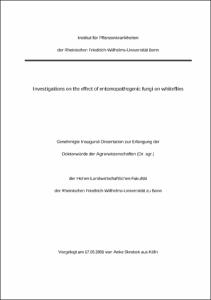Investigations on the effect of entomopathogenic fungi on whiteflies

Investigations on the effect of entomopathogenic fungi on whiteflies

| dc.contributor.advisor | Dehne, Heinz-Wilhelm | |
| dc.contributor.author | Skrobek, Anke | |
| dc.date.accessioned | 2020-04-03T12:19:51Z | |
| dc.date.available | 2020-04-03T12:19:51Z | |
| dc.date.issued | 2001 | |
| dc.identifier.uri | https://hdl.handle.net/20.500.11811/1688 | |
| dc.description.abstract | The entomopathogenic fungus Paecilomyces fumosoroseus is well-known for its broad host-spectrum and efficacy against many kinds of insects. Although its effectiveness against soil-borne arthropods has already been described over 100 years ago, Metarhizium anisopliae has only recently been cited as pathogenic to homopteran pests. In the present study different isolates of both microbial control agents were evaluated for their potential to control the whitefly species Trialeurodes vaporariorum and Bemisia argentifolii. Whiteflies are one of the most important arthropod pests of greenhouse and field crops, B. argentifolii occurring mostly in tropical and subtropical climates and T. vaporariorum being the pre-dominant species in Northern Europe. Many isolates of P. fumosoroseus and M. anisopliae, originating in different climatic regions, were found to be effective against all larval stages of both whitefly species. For the integration of this biological control agent into crop protection systems, a possible synergism between the entomopathogens and insecticides from the group of the chitin synthesis inhibitors was investigated. Although fungi and insecticide acted synergistically when applied with a time interval, control of whiteflies was not sufficient for an effective, practical pest control. In contrast, corresponding investigations on Spodoptera littoralis, the Egyptian cotton leafworm, gave high mortality levels and thus offered good prospects for reducing the pesticide input. Different oils, waxes and polymeric additives were examined for their ability to enhance the efficacy of the biological control agents. Two polymeric additives were found to increase the shelf-life at room temperature of conidia of M. anisopliae when conidia were dried within the formulation. Microscopical studies using fluorescence, low temperature scanning electron and confocal laser scanning microscope indicated positive effects of Addit ® (Koppert, Netherlands) and a polymeric additive on the distribution of formulations -and hence conidia- on leaf and insect surfaces. Spore germination, speed of kill and mortality of the target insect were also found to be enhanced. Both additives offered good prospects for optimising the efficacy of entomopathogenic fungi against B. argentifolii and T. vaporariorum, thus indicating high potential for the integration in the framework of an IPM strategy | en |
| dc.description.abstract | Untersuchungen zur Wirkung von entomopathogenen Pilzen auf die Weiße Fliege Der entomopathogene Pilz Paecilomyces fumosoroseus ist bekannt für sein breites Wirtsspektrum und seine Wirksamkeit gegen verschiedene Insektenarten. Die Pathogenität von Metarhizium anisopliae gegen pflanzensaugende Insekten ist erst kürzlich bekannt geworden, obwohl seine Wirksamkeit gegen bodenbürtige Insekten bereits vor über 100 Jahren beschrieben wurde. In der vorliegenden Arbeit wurde das Potential verschiedener Isolate beider Pilze zur Kontrolle der Weißen Fliegen Bemisia argentifolii und Trialeurodes vaporariorum untersucht. Weiße Fliegen zählen weltweit zu den bedeutendsten Schädlingen, dabei tritt B. argentifolii hauptsächlich in tropischen und subtropischen Gebieten auf, während T. vaporariorum die dominierende Art in Nord Europa ist. Einige Isolate von P. fumosoroseus und M. anisopliae aus unterschiedlichen klimatischen Regionen zeigten hohe Wirksamkeit gegen alle Larvenstadien beider Insektenarten. Ein potentieller Synergismus zwischen den Insektenpathogenen und Insektiziden aus der Gruppe der Chitin Synthesehemmer wurde untersucht, um die biologische Bekämpfungsmaßnahme in bestehende Pflanzenschutzsysteme zu integrieren. Obwohl bei einer zeitversetzten Applikation synergistische Effekte beobachtet wurden, war die Mortalität von T. vaporariorum zu niedrig für eine ausreichende Kontrolle des Insekts. Im Gegensatz dazu zeigten vergleichbare Versuche mit Spodoptera littoralis, dem Ägyptischen Baumwollkapselwurm, eine Steigerung in der Mortalität und somit eine gute Möglichkeit zur Reduzierung des Pestizideinsatzes. Das Potential von verschiedenen Ölen und Polymerzusätzen, die Wirksamkeit der Antagonisten zu steigern, wurde untersucht. Zwei Polymere konnten die Lagerfähigkeit von M. anisopliae bei Raumtemperatur signifikant erhöhen. Mikroskopische Untersuchungen mittels Fluoreszenz, Raster Elektronen und Konfokaler Laser Scan Mikroskopie zeigten positive Effekte des Ölpräparates Addit ® und eines Polymers auf die Verteilung von Formulierung und Konidien auf Blättern und Insekten. Sporenkeimung, Geschwindigkeit der Pathogenese und Mortalität der Zielinsekten wurden ebenfalls erhöht. Beide Additive steigerten die Wirksamkeit entomopathogener Pilze gegen die Weiße Fliege und bieten somit die Möglichkeit einer Integration der biologischen Schädlingsbekämpfung in ein IPM-Programm unter Gewächshausbedingungen. | en |
| dc.language.iso | eng | |
| dc.rights | In Copyright | |
| dc.rights.uri | http://rightsstatements.org/vocab/InC/1.0/ | |
| dc.subject | Whitelies | |
| dc.subject | Entomopathologens | |
| dc.subject | Metarhizium | |
| dc.subject.ddc | 580 Pflanzen (Botanik) | |
| dc.title | Investigations on the effect of entomopathogenic fungi on whiteflies | |
| dc.type | Dissertation oder Habilitation | |
| dc.publisher.name | Universitäts- und Landesbibliothek Bonn | |
| dc.publisher.location | Bonn | |
| dc.rights.accessRights | openAccess | |
| dc.identifier.urn | https://nbn-resolving.org/urn:nbn:de:hbz:5n-02014 | |
| ulbbn.pubtype | Erstveröffentlichung | |
| ulbbnediss.affiliation.name | Rheinische Friedrich-Wilhelms-Universität Bonn | |
| ulbbnediss.affiliation.location | Bonn | |
| ulbbnediss.thesis.level | Dissertation | |
| ulbbnediss.dissID | 201 | |
| ulbbnediss.date.accepted | 12.11.2001 | |
| ulbbnediss.institute | Landwirtschaftliche Fakultät : Institut für Nutzpflanzenwissenschaften und Ressourcenschutz (INRES) | |
| ulbbnediss.fakultaet | Landwirtschaftliche Fakultät | |
| dc.contributor.coReferee | Wittmann, Dieter |
Dateien zu dieser Ressource
Das Dokument erscheint in:
-
E-Dissertationen (1120)




